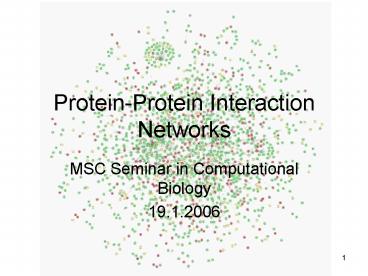ProteinProtein Interaction Networks - PowerPoint PPT Presentation
1 / 39
Title:
ProteinProtein Interaction Networks
Description:
From Greek 'proteios' meaning 'of first importance' ... Protein-Protein Interaction networks. Unraveling the biochemistry of cells: ... – PowerPoint PPT presentation
Number of Views:225
Avg rating:3.0/5.0
Title: ProteinProtein Interaction Networks
1
Protein-Protein Interaction Networks
- MSC Seminar in Computational Biology
- 19.1.2006
2
Proteins
- From Greek proteios meaning of first
importance - Involved in almost every process in the cell
- Signal transduction
- catalysis and inhibition of interactions
- Ligands transportation
- Structural role
3
Protein-Protein Interaction networks
- Unraveling the biochemistry of cells
- Associating functions with known proteins
- Identifying functional modules
- Different types of interactions
- In yeast 6000 proteins having 106 potential
interactions, out of which 30,000 are real
4
Inferring PPI
- Experimental Approaches
- Small scale experiments
- Structural data
- Yeast two-hybrid system
- Affinity purification (Pull-Down Assays, phage
display, ribosomal display) Detection (Mass
Spectrometry) - Chemical linkers
- Protein Arrays
- Additional experimental information
- Localization data
- mRNA co-expression
5
Inferring PPI
- Computational Approaches
- Genomic context of genes
- Fusion
- Neighborhood
- Similar phylogenetic profiles
- Correlated mutations
- Domain analysis
- Structural data
- Cross species evidences
6
PPI Databases
- DIP - Database of Interacting Proteins (small
scale) - MIPS (yeast)
- KEGG pathways DB
- BIND - proteinprotein, proteinRNA, proteinDNA
and proteinsmall-molecule interactions - PROTEOME function, localization, interactions
- IND - The Biomolecular Interaction Network
Database - Yeast proteom databases YPD, PombePD, CalPD
- GRID
- INTERACT - Protein-Protein Interaction database
- MINT - Molecular Interactions Database
- PROnet - Protein Interactions Database
- PIM - Helicobacter pylori interaction maps
7
Comparing the DBs
- High FP rate in high- throughput exp.
- Disagreement between benchmark sets
- Integration by probabilistic/ML approaches
8
PPI Servers
- STRING (protein associations, naïve base)
- PLEX protein link explorer (phylogenetic
profiles comparison) - Predictome combining predictors (phylogenetic
profiling, gene fusion, chromosomal proximity)
9
The Topology of PPI Networks
- Small-world
- Scale free
- Recurring motifs (Barabasi et al. Nature genetics
2003)
10
Evidence for dynamically organized modularity in
the yeast protein-protein interaction
networkVidal et al. Nature, 2004
- Investigating the role of hubs in the network
considering temporal data - Data
- Filtered yeast interactome (FYI)
- mRNA expression data (yeast expression compendium)
11
CC Distribution
-- hubs -- non-hubs -- randomized net
12
Data Party Hubs
13
Their Role in the Net
Full Net
No Date Hubs
No Party Hubs
14
Additional Dimension to the Net
Date Hubs
Party Hubs
Hubs
15
Characteristic Path Length
-- Random -- Hubs -- Party -- Date
16
Largest Component
17
Date Hubs Divide the Net into Homogeneous Modules
18
The CC is Still Varying
19
Summary
- The partition to Date and Party hubs reveals an
organized modularity in the network - Party hubs belong to specific modules
- Date hubs connect different modules
- Their essentiality is similar
- Date hubs are involved in more genetic
interactions, and thus perturbing them makes the
genome more sensitive to other perturbations
20
Dynamic Complex Formation During the Yeast Cell
Cycle Bork et al. Science 2005
- Adding a temporal aspect to the network
- Data
- 600 periodically expressed genes assigned to the
point in the cell cycle where its expression
peaks. - Physical interaction net of these proteins (high
confidence interactions combined from Y2H,
complex pull-down, MIPS DB) - Constitutively expressed proteins that interact
with the above were added to the net
21
(No Transcript)
22
- Then net 184 dynamic, 116 static proteins
- 412 proteins do not participate in any
interaction (transient?)
23
Results
- Interacting proteins are more likely to be
expressed close in time
24
Results
- Static proteins participate in interactions
throughout the entire cycle
25
Conclusions
- JIT assembly instead of JIT synthesis
- Simpler regulation
- Explains the low evolutionary conservation of
transcription times of genes - Regulation of specificity of cdc28p to different
substrates by different cyclins
26
Conclusions
- More dynamic (27) than static (8) proteins are
Cdc28p targets fine tuning by additional
regulation through phosphorilation which marks
them for degradation - Dynamic proteins have more (PEST) degradation
signals
27
Conclusions
- Party Date Hubs
28
Summary
- Regulation mechanisms
- JIT assembly
- Fine tuning controlling the degradation
- Time-dependent specificity
29
Global network analysis of phenotypic effects
Protein network and toxicity modulation in
Saccharomyces cerevisiaeSamson et al. PNAS 2004
- network analysis in a functional context
- Data
- DIP - The Database of Interacting Proteins
- (4,686, proteins 14,493 interactions)
- Classification of the proteins to
- Essential
- toxicity-modulating
- no-phenotype
- from previous genomic phenotyping study of S.
cerevisiae - (4,733 non-essential proteins 4 DNA-damaging
agents (MMS,4NQO, t-BuOOH, 2540nm UV radiation))
30
Degree Distribution
31
The Mean Degree
Essential Toxicity-Modulating Random
Non-Essential No-Phenotype
Mean Degree
32
Shortest-Path Length
33
Centrality
34
Clustering Coefficient
- Whether two neighbors of a node interact
- Ess ToxMod gt Random gt nonEssnoPhe
- Results are still valid when the randomization
keeps the original degrees
35
Comparison to Metabolic Subnet.
- ? The metabolic net is more similar to the random
net
36
Comparison to Metabolic Subnet. Barabasi et al.
Nature 2000
37
Summary
- Toxicity modulating PPI are similar to essential
proteins in aspects of - high degree
- Small shortest path
- More clustered
- Toxicity modulating proteins are essential under
certain conditions - Highly coordinated response to damage
- The Metabolic network example proves that not all
cellular functions will show a similar behavior
38
Future Goals
- Proceeding to multi-cellular organisms (fly,
worm) and to human - Importing interactions between organisms
(although full modules might be missing) - Experimental approaches not yet sufficient for
number of genes in mammals
39
Thank You!































